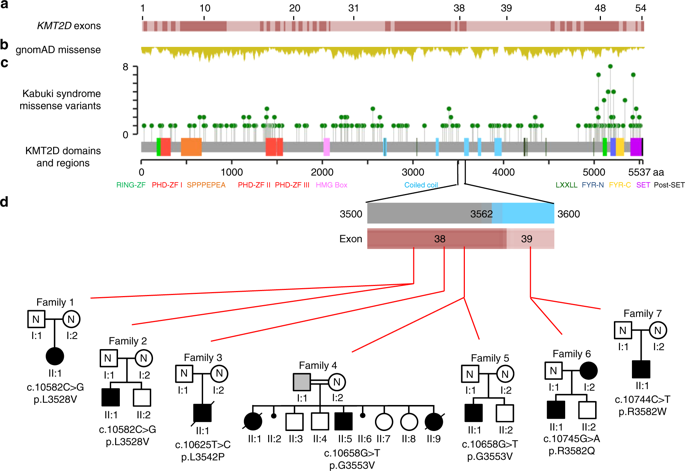当前位置:
X-MOL 学术
›
Genet. Med.
›
论文详情
Our official English website, www.x-mol.net, welcomes your feedback! (Note: you will need to create a separate account there.)
A restricted spectrum of missense KMT2D variants cause a multiple malformations disorder distinct from Kabuki syndrome.
Genetics in Medicine ( IF 8.8 ) Pub Date : 2020-01-17 , DOI: 10.1038/s41436-019-0743-3 Sara Cuvertino 1, 2 , Verity Hartill 3, 4 , Alice Colyer 5 , Terence Garner 6 , Nisha Nair 7 , Lihadh Al-Gazali 8 , Natalie Canham 9, 10 , Victor Faundes 1, 11 , Frances Flinter 12 , Jozef Hertecant 13 , Muriel Holder-Espinasse 12 , Brian Jackson 5 , Sally Ann Lynch 14 , Fatima Nadat 5 , Vagheesh M Narasimhan 15 , Michelle Peckham 5 , Robert Sellers 6 , Marco Seri 16 , Francesca Montanari 16 , Laura Southgate 17, 18 , Gabriella Maria Squeo 19 , Richard Trembath 18 , David van Heel 20 , Santina Venuto 19 , Daniel Weisberg 21 , Karen Stals 22 , Sian Ellard 22, 23 , , Anne Barton 7 , Susan J Kimber 2 , Eamonn Sheridan 3, 4 , Giuseppe Merla 19 , Adam Stevens 6 , Colin A Johnson 3 , Siddharth Banka 1, 24
Genetics in Medicine ( IF 8.8 ) Pub Date : 2020-01-17 , DOI: 10.1038/s41436-019-0743-3 Sara Cuvertino 1, 2 , Verity Hartill 3, 4 , Alice Colyer 5 , Terence Garner 6 , Nisha Nair 7 , Lihadh Al-Gazali 8 , Natalie Canham 9, 10 , Victor Faundes 1, 11 , Frances Flinter 12 , Jozef Hertecant 13 , Muriel Holder-Espinasse 12 , Brian Jackson 5 , Sally Ann Lynch 14 , Fatima Nadat 5 , Vagheesh M Narasimhan 15 , Michelle Peckham 5 , Robert Sellers 6 , Marco Seri 16 , Francesca Montanari 16 , Laura Southgate 17, 18 , Gabriella Maria Squeo 19 , Richard Trembath 18 , David van Heel 20 , Santina Venuto 19 , Daniel Weisberg 21 , Karen Stals 22 , Sian Ellard 22, 23 , , Anne Barton 7 , Susan J Kimber 2 , Eamonn Sheridan 3, 4 , Giuseppe Merla 19 , Adam Stevens 6 , Colin A Johnson 3 , Siddharth Banka 1, 24
Affiliation

|
PURPOSE
To investigate if specific exon 38 or 39 KMT2D missense variants (MVs) cause a condition distinct from Kabuki syndrome type 1 (KS1).
METHODS
Multiple individuals, with MVs in exons 38 or 39 of KMT2D that encode a highly conserved region of 54 amino acids flanked by Val3527 and Lys3583, were identified and phenotyped. Functional tests were performed to study their pathogenicity and understand the disease mechanism.
RESULTS
The consistent clinical features of the affected individuals, from seven unrelated families, included choanal atresia, athelia or hypoplastic nipples, branchial sinus abnormalities, neck pits, lacrimal duct anomalies, hearing loss, external ear malformations, and thyroid abnormalities. None of the individuals had intellectual disability. The frequency of clinical features, objective software-based facial analysis metrics, and genome-wide peripheral blood DNA methylation patterns in these patients were significantly different from that of KS1. Circular dichroism spectroscopy indicated that these MVs perturb KMT2D secondary structure through an increased disordered to ɑ-helical transition.
CONCLUSION
KMT2D MVs located in a specific region spanning exons 38 and 39 and affecting highly conserved residues cause a novel multiple malformations syndrome distinct from KS1. Unlike KMT2D haploinsufficiency in KS1, these MVs likely result in disease through a dominant negative mechanism.
中文翻译:

有限范围的错义 KMT2D 变体导致与歌舞伎综合征不同的多种畸形疾病。
目的 调查特定外显子 38 或 39 KMT2D 错义变异 (MV) 是否会导致不同于 1 型歌舞伎综合征 (KS1) 的疾病。方法 鉴定和表型鉴定多个个体,在 KMT2D 的外显子 38 或 39 中编码一个由 54 个氨基酸组成的高度保守区域,两侧为 Val3527 和 Lys3583 的 MV。进行功能测试以研究其致病性并了解疾病机制。结果 来自七个无关家庭的受影响个体的一致临床特征包括后鼻孔闭锁、动脉瘤或乳头发育不全、鳃窦异常、颈窝、泪管异常、听力丧失、外耳畸形和甲状腺异常。没有一个人有智力障碍。临床特征的频率,这些患者基于客观软件的面部分析指标和全基因组外周血 DNA 甲基化模式与 KS1 显着不同。圆二色光谱表明,这些 MV 通过增加无序到 ɑ-螺旋转变来扰乱 KMT2D 二级结构。结论 KMT2D MVs 位于跨越外显子 38 和 39 的特定区域并影响高度保守的残基,导致一种不同于 KS1 的新型多发性畸形综合征。与 KS1 中的 KMT2D 单倍体不足不同,这些 MV 可能通过显性负性机制导致疾病。圆二色光谱表明,这些 MV 通过增加无序到 ɑ-螺旋转变来扰乱 KMT2D 二级结构。结论 KMT2D MVs 位于跨越外显子 38 和 39 的特定区域并影响高度保守的残基,导致一种不同于 KS1 的新型多发性畸形综合征。与 KS1 中的 KMT2D 单倍体不足不同,这些 MV 可能通过显性负性机制导致疾病。圆二色光谱表明,这些 MV 通过增加无序到 ɑ-螺旋转变来扰乱 KMT2D 二级结构。结论 KMT2D MVs 位于跨越外显子 38 和 39 的特定区域并影响高度保守的残基,导致一种不同于 KS1 的新型多发性畸形综合征。与 KS1 中的 KMT2D 单倍体不足不同,这些 MV 可能通过显性负性机制导致疾病。
更新日期:2020-01-17
中文翻译:

有限范围的错义 KMT2D 变体导致与歌舞伎综合征不同的多种畸形疾病。
目的 调查特定外显子 38 或 39 KMT2D 错义变异 (MV) 是否会导致不同于 1 型歌舞伎综合征 (KS1) 的疾病。方法 鉴定和表型鉴定多个个体,在 KMT2D 的外显子 38 或 39 中编码一个由 54 个氨基酸组成的高度保守区域,两侧为 Val3527 和 Lys3583 的 MV。进行功能测试以研究其致病性并了解疾病机制。结果 来自七个无关家庭的受影响个体的一致临床特征包括后鼻孔闭锁、动脉瘤或乳头发育不全、鳃窦异常、颈窝、泪管异常、听力丧失、外耳畸形和甲状腺异常。没有一个人有智力障碍。临床特征的频率,这些患者基于客观软件的面部分析指标和全基因组外周血 DNA 甲基化模式与 KS1 显着不同。圆二色光谱表明,这些 MV 通过增加无序到 ɑ-螺旋转变来扰乱 KMT2D 二级结构。结论 KMT2D MVs 位于跨越外显子 38 和 39 的特定区域并影响高度保守的残基,导致一种不同于 KS1 的新型多发性畸形综合征。与 KS1 中的 KMT2D 单倍体不足不同,这些 MV 可能通过显性负性机制导致疾病。圆二色光谱表明,这些 MV 通过增加无序到 ɑ-螺旋转变来扰乱 KMT2D 二级结构。结论 KMT2D MVs 位于跨越外显子 38 和 39 的特定区域并影响高度保守的残基,导致一种不同于 KS1 的新型多发性畸形综合征。与 KS1 中的 KMT2D 单倍体不足不同,这些 MV 可能通过显性负性机制导致疾病。圆二色光谱表明,这些 MV 通过增加无序到 ɑ-螺旋转变来扰乱 KMT2D 二级结构。结论 KMT2D MVs 位于跨越外显子 38 和 39 的特定区域并影响高度保守的残基,导致一种不同于 KS1 的新型多发性畸形综合征。与 KS1 中的 KMT2D 单倍体不足不同,这些 MV 可能通过显性负性机制导致疾病。


























 京公网安备 11010802027423号
京公网安备 11010802027423号